Case Study: Chronic Heart Failure Management and Treatment Analysis
VerifiedAdded on 2020/02/03
|10
|2420
|109
Case Study
AI Summary
This case study focuses on a 75-year-old overweight man, Charlie, diagnosed with chronic heart failure due to cardiomyopathy and hypertension, presenting with peripheral edema and tachycardia. The study reviews the importance of diet, exercise, and diuretics in managing chronic heart failure. It explores evidence-based practices, including dietary modifications (low-salt diet, DASH diet), exercise interventions, and the use of diuretics for symptomatic relief and improved exercise capacity. The literature review highlights the benefits of these interventions, supported by studies on mortality, morbidity, and quality of life. Implications for clinical practice emphasize the need for tailored dietary advice, strength training, and the optimization of diuretic therapy in patients with heart failure. The case study underscores the importance of a holistic approach to treatment, integrating lifestyle modifications and medical interventions to improve patient outcomes.
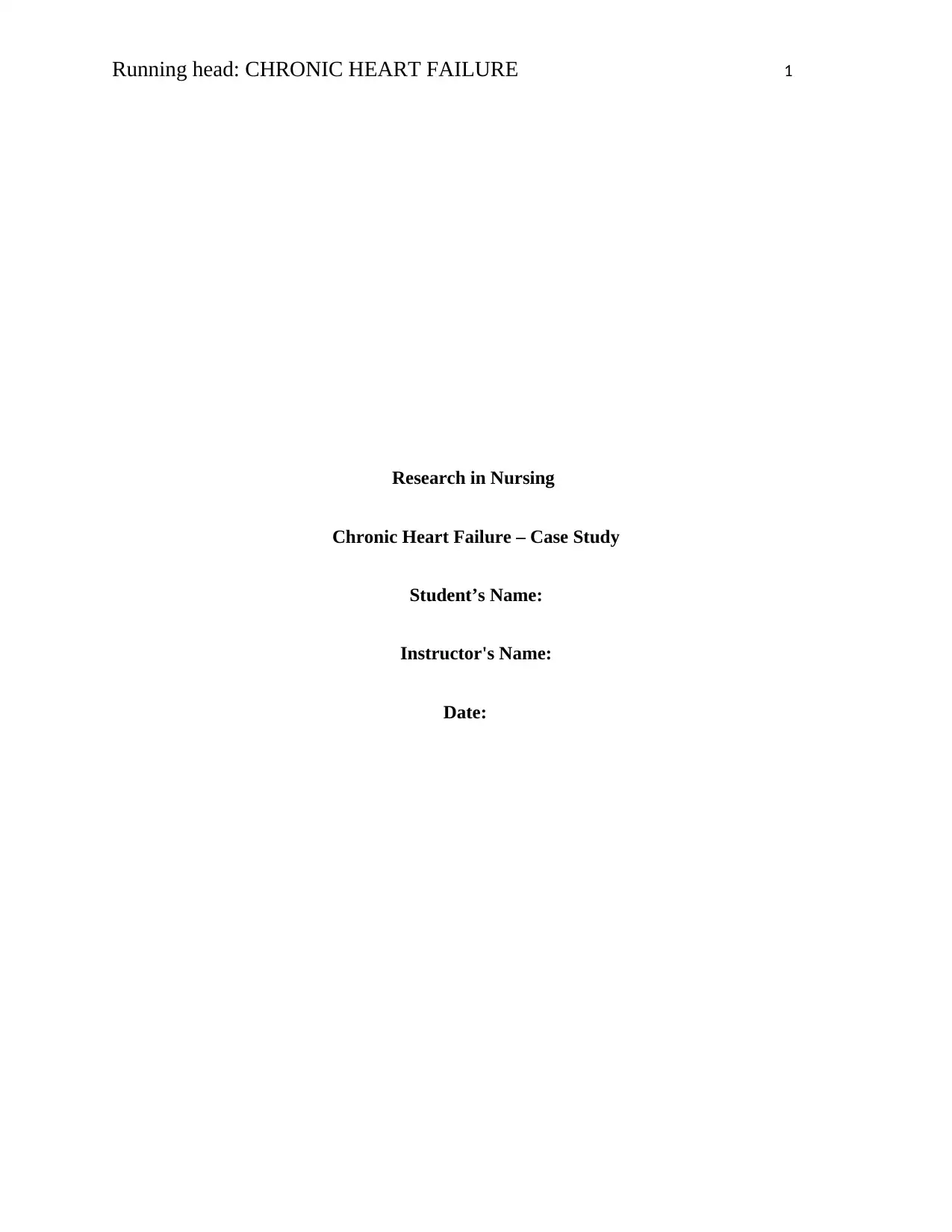
Running head: CHRONIC HEART FAILURE 1
Research in Nursing
Chronic Heart Failure – Case Study
Student’s Name:
Instructor's Name:
Date:
Research in Nursing
Chronic Heart Failure – Case Study
Student’s Name:
Instructor's Name:
Date:
Paraphrase This Document
Need a fresh take? Get an instant paraphrase of this document with our AI Paraphraser

CHRONIC HEART FAILURE 2
Chronic Heart Failure – Case Study
Introduction
In patients with chronic heart failure due to hypertension, the physician must direct the patient to
exercise well and diet appropriately along with prescribing diuretics to take care of the patient.
Diets and exercise are lifestyle modifications that enable a person to live healthily, maintain
body weight or reduce it when needed, gain strength and vitality, and offset chronic heart failure.
In the present case, it is mentioned that Charlie is a 75 year old overweight man who has
co-morbid –problems such as peripheral oedema and tachycardia. Two years ago, Charlie has a
chronic heart failure as a result of that he has cardiomyopathy and hypertension and because of
that he is feeling unwell from past several years. Thus, on the basis of this case, it can be said
that Charlie needs to get proper clinical treatment so that health intervention can be improved.
This can also assist Charlie to get proper treatment of the heart disease.
Literature Review
Diet for Heart Failure
Diet determines the risk to heart disease to a large extent. This review undertaken by Rees et al.
(2013) had the aim of providing dietary advice to healthy adults. The authors found 44 trials
where healthy adults received medical advice on diet or no advice. The advice for dietary
modifications included cutting down on fats and salt intake while increasing fruit and fiber and
vegetable intake.
Chronic Heart Failure – Case Study
Introduction
In patients with chronic heart failure due to hypertension, the physician must direct the patient to
exercise well and diet appropriately along with prescribing diuretics to take care of the patient.
Diets and exercise are lifestyle modifications that enable a person to live healthily, maintain
body weight or reduce it when needed, gain strength and vitality, and offset chronic heart failure.
In the present case, it is mentioned that Charlie is a 75 year old overweight man who has
co-morbid –problems such as peripheral oedema and tachycardia. Two years ago, Charlie has a
chronic heart failure as a result of that he has cardiomyopathy and hypertension and because of
that he is feeling unwell from past several years. Thus, on the basis of this case, it can be said
that Charlie needs to get proper clinical treatment so that health intervention can be improved.
This can also assist Charlie to get proper treatment of the heart disease.
Literature Review
Diet for Heart Failure
Diet determines the risk to heart disease to a large extent. This review undertaken by Rees et al.
(2013) had the aim of providing dietary advice to healthy adults. The authors found 44 trials
where healthy adults received medical advice on diet or no advice. The advice for dietary
modifications included cutting down on fats and salt intake while increasing fruit and fiber and
vegetable intake.
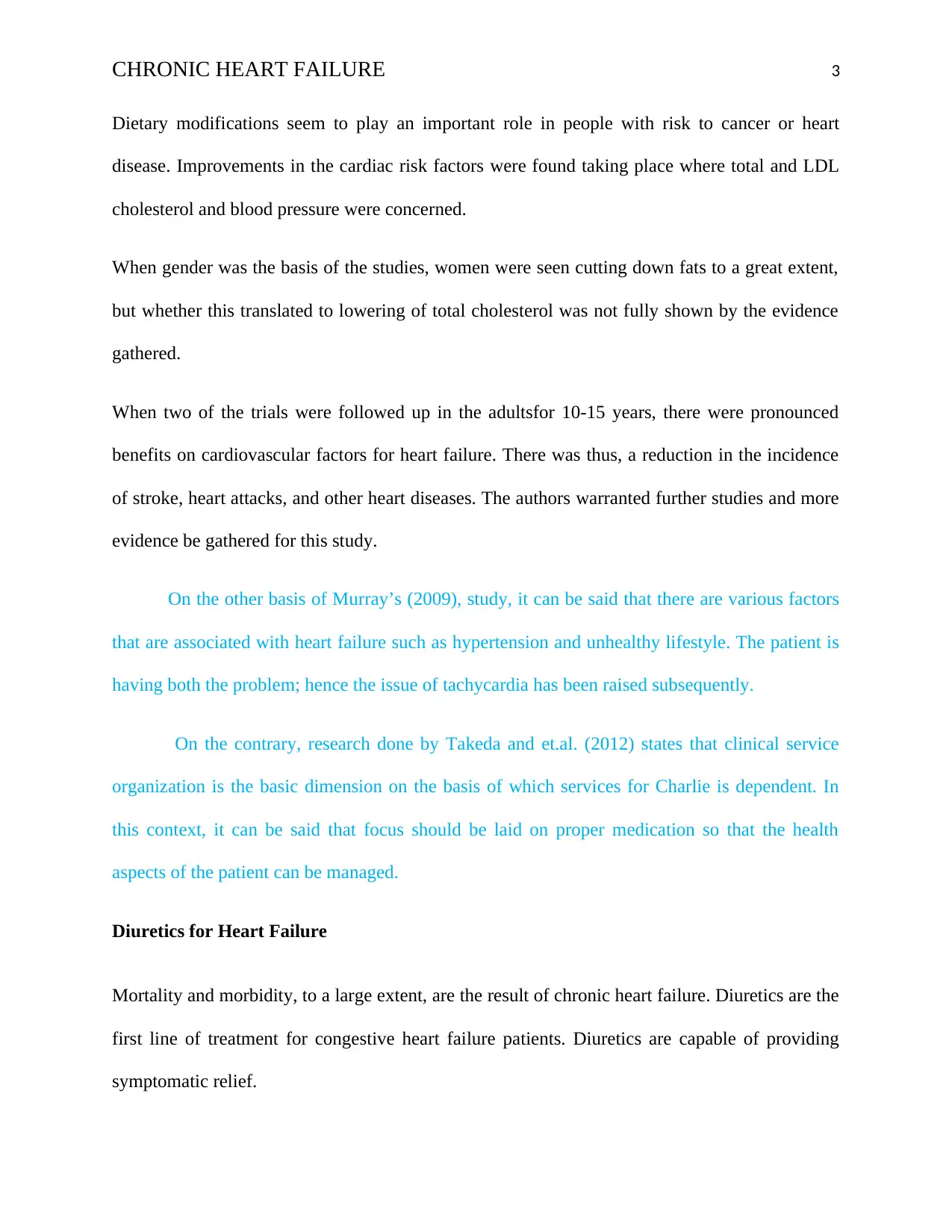
CHRONIC HEART FAILURE 3
Dietary modifications seem to play an important role in people with risk to cancer or heart
disease. Improvements in the cardiac risk factors were found taking place where total and LDL
cholesterol and blood pressure were concerned.
When gender was the basis of the studies, women were seen cutting down fats to a great extent,
but whether this translated to lowering of total cholesterol was not fully shown by the evidence
gathered.
When two of the trials were followed up in the adultsfor 10-15 years, there were pronounced
benefits on cardiovascular factors for heart failure. There was thus, a reduction in the incidence
of stroke, heart attacks, and other heart diseases. The authors warranted further studies and more
evidence be gathered for this study.
On the other basis of Murray’s (2009), study, it can be said that there are various factors
that are associated with heart failure such as hypertension and unhealthy lifestyle. The patient is
having both the problem; hence the issue of tachycardia has been raised subsequently.
On the contrary, research done by Takeda and et.al. (2012) states that clinical service
organization is the basic dimension on the basis of which services for Charlie is dependent. In
this context, it can be said that focus should be laid on proper medication so that the health
aspects of the patient can be managed.
Diuretics for Heart Failure
Mortality and morbidity, to a large extent, are the result of chronic heart failure. Diuretics are the
first line of treatment for congestive heart failure patients. Diuretics are capable of providing
symptomatic relief.
Dietary modifications seem to play an important role in people with risk to cancer or heart
disease. Improvements in the cardiac risk factors were found taking place where total and LDL
cholesterol and blood pressure were concerned.
When gender was the basis of the studies, women were seen cutting down fats to a great extent,
but whether this translated to lowering of total cholesterol was not fully shown by the evidence
gathered.
When two of the trials were followed up in the adultsfor 10-15 years, there were pronounced
benefits on cardiovascular factors for heart failure. There was thus, a reduction in the incidence
of stroke, heart attacks, and other heart diseases. The authors warranted further studies and more
evidence be gathered for this study.
On the other basis of Murray’s (2009), study, it can be said that there are various factors
that are associated with heart failure such as hypertension and unhealthy lifestyle. The patient is
having both the problem; hence the issue of tachycardia has been raised subsequently.
On the contrary, research done by Takeda and et.al. (2012) states that clinical service
organization is the basic dimension on the basis of which services for Charlie is dependent. In
this context, it can be said that focus should be laid on proper medication so that the health
aspects of the patient can be managed.
Diuretics for Heart Failure
Mortality and morbidity, to a large extent, are the result of chronic heart failure. Diuretics are the
first line of treatment for congestive heart failure patients. Diuretics are capable of providing
symptomatic relief.
⊘ This is a preview!⊘
Do you want full access?
Subscribe today to unlock all pages.

Trusted by 1+ million students worldwide
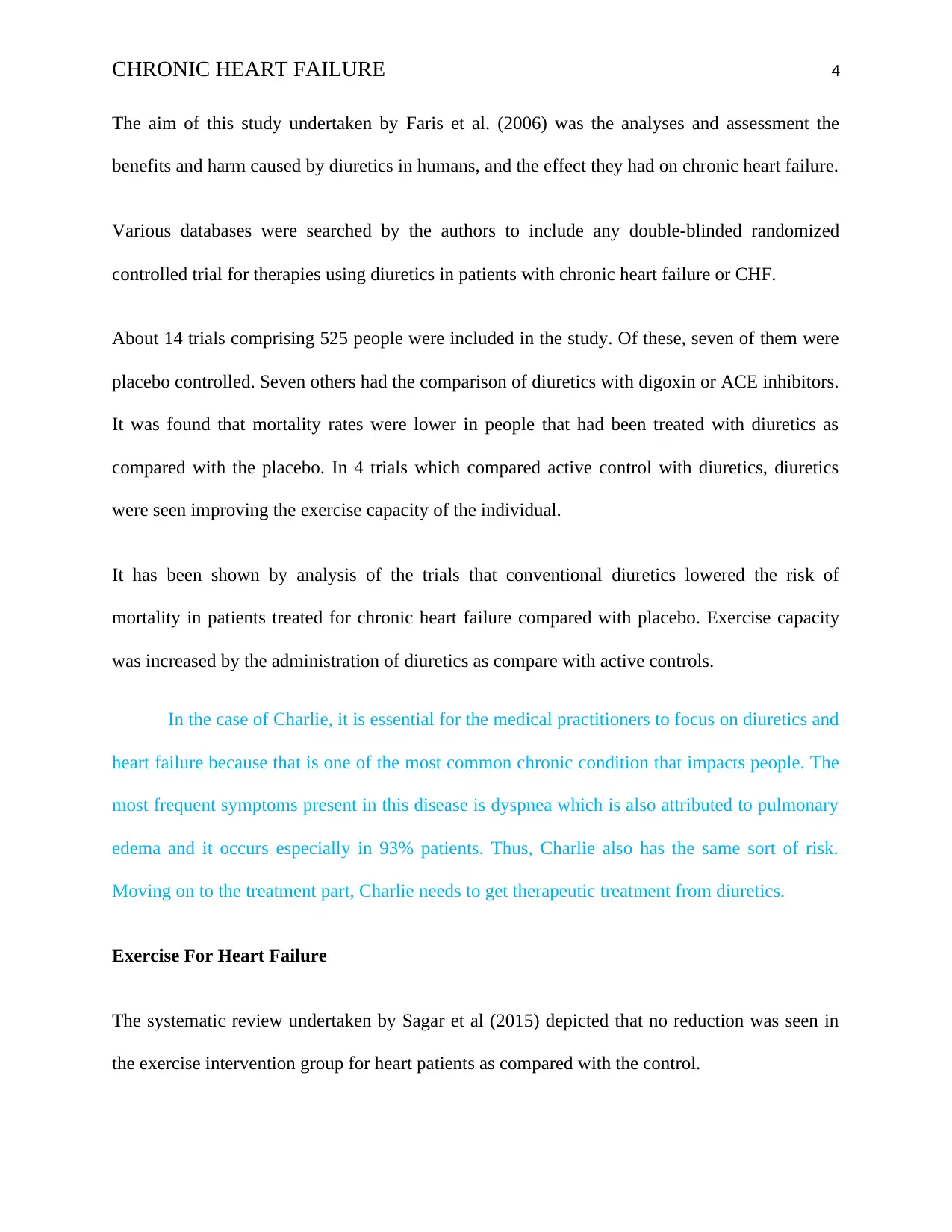
CHRONIC HEART FAILURE 4
The aim of this study undertaken by Faris et al. (2006) was the analyses and assessment the
benefits and harm caused by diuretics in humans, and the effect they had on chronic heart failure.
Various databases were searched by the authors to include any double-blinded randomized
controlled trial for therapies using diuretics in patients with chronic heart failure or CHF.
About 14 trials comprising 525 people were included in the study. Of these, seven of them were
placebo controlled. Seven others had the comparison of diuretics with digoxin or ACE inhibitors.
It was found that mortality rates were lower in people that had been treated with diuretics as
compared with the placebo. In 4 trials which compared active control with diuretics, diuretics
were seen improving the exercise capacity of the individual.
It has been shown by analysis of the trials that conventional diuretics lowered the risk of
mortality in patients treated for chronic heart failure compared with placebo. Exercise capacity
was increased by the administration of diuretics as compare with active controls.
In the case of Charlie, it is essential for the medical practitioners to focus on diuretics and
heart failure because that is one of the most common chronic condition that impacts people. The
most frequent symptoms present in this disease is dyspnea which is also attributed to pulmonary
edema and it occurs especially in 93% patients. Thus, Charlie also has the same sort of risk.
Moving on to the treatment part, Charlie needs to get therapeutic treatment from diuretics.
Exercise For Heart Failure
The systematic review undertaken by Sagar et al (2015) depicted that no reduction was seen in
the exercise intervention group for heart patients as compared with the control.
The aim of this study undertaken by Faris et al. (2006) was the analyses and assessment the
benefits and harm caused by diuretics in humans, and the effect they had on chronic heart failure.
Various databases were searched by the authors to include any double-blinded randomized
controlled trial for therapies using diuretics in patients with chronic heart failure or CHF.
About 14 trials comprising 525 people were included in the study. Of these, seven of them were
placebo controlled. Seven others had the comparison of diuretics with digoxin or ACE inhibitors.
It was found that mortality rates were lower in people that had been treated with diuretics as
compared with the placebo. In 4 trials which compared active control with diuretics, diuretics
were seen improving the exercise capacity of the individual.
It has been shown by analysis of the trials that conventional diuretics lowered the risk of
mortality in patients treated for chronic heart failure compared with placebo. Exercise capacity
was increased by the administration of diuretics as compare with active controls.
In the case of Charlie, it is essential for the medical practitioners to focus on diuretics and
heart failure because that is one of the most common chronic condition that impacts people. The
most frequent symptoms present in this disease is dyspnea which is also attributed to pulmonary
edema and it occurs especially in 93% patients. Thus, Charlie also has the same sort of risk.
Moving on to the treatment part, Charlie needs to get therapeutic treatment from diuretics.
Exercise For Heart Failure
The systematic review undertaken by Sagar et al (2015) depicted that no reduction was seen in
the exercise intervention group for heart patients as compared with the control.
Paraphrase This Document
Need a fresh take? Get an instant paraphrase of this document with our AI Paraphraser
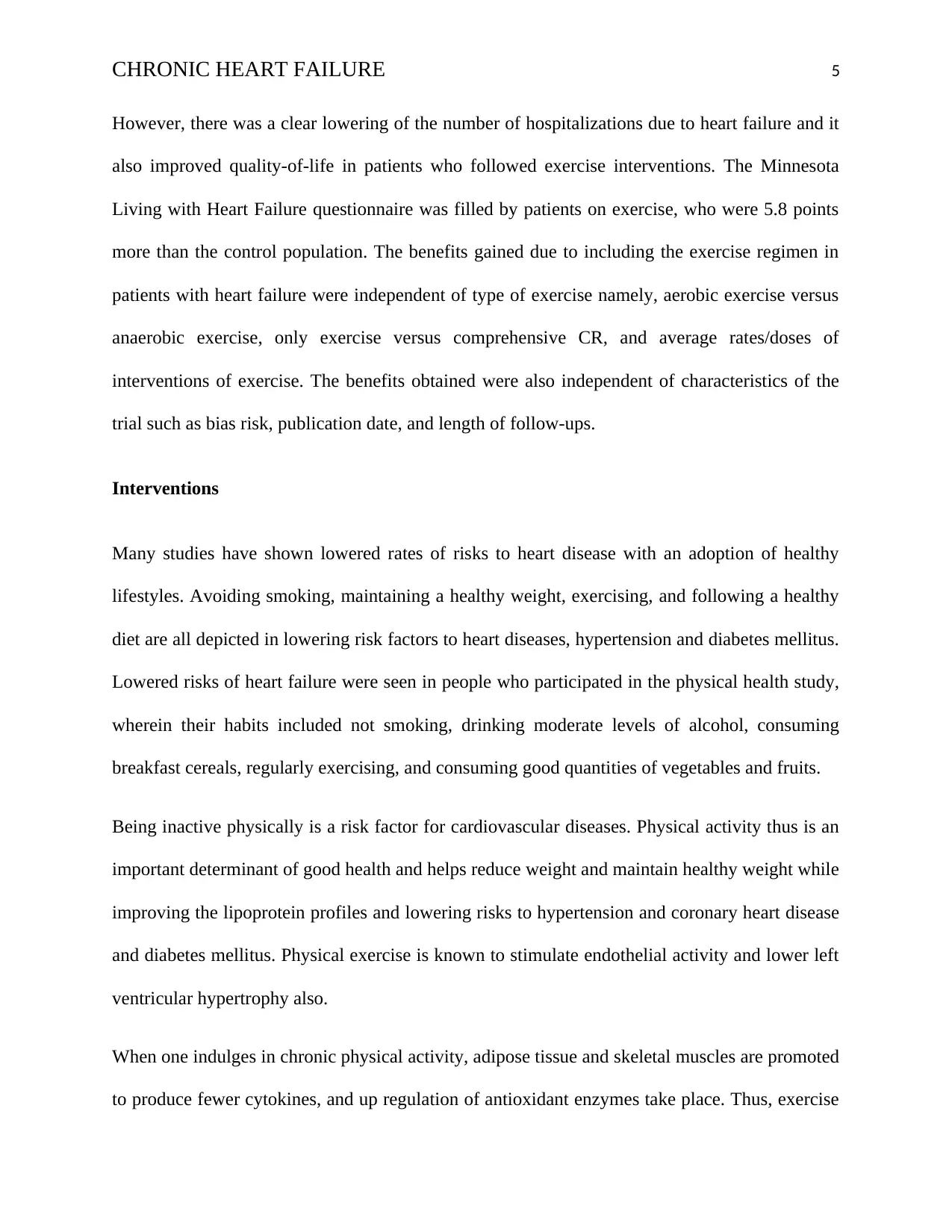
CHRONIC HEART FAILURE 5
However, there was a clear lowering of the number of hospitalizations due to heart failure and it
also improved quality-of-life in patients who followed exercise interventions. The Minnesota
Living with Heart Failure questionnaire was filled by patients on exercise, who were 5.8 points
more than the control population. The benefits gained due to including the exercise regimen in
patients with heart failure were independent of type of exercise namely, aerobic exercise versus
anaerobic exercise, only exercise versus comprehensive CR, and average rates/doses of
interventions of exercise. The benefits obtained were also independent of characteristics of the
trial such as bias risk, publication date, and length of follow-ups.
Interventions
Many studies have shown lowered rates of risks to heart disease with an adoption of healthy
lifestyles. Avoiding smoking, maintaining a healthy weight, exercising, and following a healthy
diet are all depicted in lowering risk factors to heart diseases, hypertension and diabetes mellitus.
Lowered risks of heart failure were seen in people who participated in the physical health study,
wherein their habits included not smoking, drinking moderate levels of alcohol, consuming
breakfast cereals, regularly exercising, and consuming good quantities of vegetables and fruits.
Being inactive physically is a risk factor for cardiovascular diseases. Physical activity thus is an
important determinant of good health and helps reduce weight and maintain healthy weight while
improving the lipoprotein profiles and lowering risks to hypertension and coronary heart disease
and diabetes mellitus. Physical exercise is known to stimulate endothelial activity and lower left
ventricular hypertrophy also.
When one indulges in chronic physical activity, adipose tissue and skeletal muscles are promoted
to produce fewer cytokines, and up regulation of antioxidant enzymes take place. Thus, exercise
However, there was a clear lowering of the number of hospitalizations due to heart failure and it
also improved quality-of-life in patients who followed exercise interventions. The Minnesota
Living with Heart Failure questionnaire was filled by patients on exercise, who were 5.8 points
more than the control population. The benefits gained due to including the exercise regimen in
patients with heart failure were independent of type of exercise namely, aerobic exercise versus
anaerobic exercise, only exercise versus comprehensive CR, and average rates/doses of
interventions of exercise. The benefits obtained were also independent of characteristics of the
trial such as bias risk, publication date, and length of follow-ups.
Interventions
Many studies have shown lowered rates of risks to heart disease with an adoption of healthy
lifestyles. Avoiding smoking, maintaining a healthy weight, exercising, and following a healthy
diet are all depicted in lowering risk factors to heart diseases, hypertension and diabetes mellitus.
Lowered risks of heart failure were seen in people who participated in the physical health study,
wherein their habits included not smoking, drinking moderate levels of alcohol, consuming
breakfast cereals, regularly exercising, and consuming good quantities of vegetables and fruits.
Being inactive physically is a risk factor for cardiovascular diseases. Physical activity thus is an
important determinant of good health and helps reduce weight and maintain healthy weight while
improving the lipoprotein profiles and lowering risks to hypertension and coronary heart disease
and diabetes mellitus. Physical exercise is known to stimulate endothelial activity and lower left
ventricular hypertrophy also.
When one indulges in chronic physical activity, adipose tissue and skeletal muscles are promoted
to produce fewer cytokines, and up regulation of antioxidant enzymes take place. Thus, exercise

CHRONIC HEART FAILURE 6
has preventive effects on intermediate pathways leading to heart failure, and the CHF incidence
is lowered.
In the DASH diet or Dietary Approaches to Stop Hypertension, people, are asked to consume
more of 1) grains and grain products, 2) fruits and vegetables, 3) fish, poultry, and lean meats, 4)
nonfat dairy foods, and 5) nuts, legumes, and seeds. Reduced consumption of fat, red meat, and
sugar along with decreased amounts of consumption of sodium are recommended. About 37% of
participants who adhered to the DAHS diet had reduction of risks to heart failure.
Heart failure is prevented by the DASH diet by the lowering of blood pressure and coronary
heart disease (Appel et al., 1997). The DASH diet helps reduce oxidative stress and LDL
cholesterol level and promotes estrogenic effects by phytochemicals that are beneficial to the
heart.
A 30% lowered rate of heart failure was seen in people consuming whole grain breakfasts
(Djoussé and Gaziano, 2007);a 20-31% reduced risk of heart failure was observed in people
consuming fish (Mozaffarian et al., 2005). Consumption of over 100 mmol of sodium caused an
increase in heart failure in people by 26% (He et al., 2002). Animals fed on high fructose diets
had worse survival following more cardiac remodeling.
Wholegrain cereals help reduce the incidence of heart failure due to a positive effect on weight,
and thus, reduction of myocardial infarction and hypertension, and diabetes mellitus. Potassium
found in whole grains may reduce blood pressure, phytoestrogens improve insulin sensitivity,
and lipid levels and other components of grains may cause beneficial amounts of lipids and
homocysteine levels be maintained.
has preventive effects on intermediate pathways leading to heart failure, and the CHF incidence
is lowered.
In the DASH diet or Dietary Approaches to Stop Hypertension, people, are asked to consume
more of 1) grains and grain products, 2) fruits and vegetables, 3) fish, poultry, and lean meats, 4)
nonfat dairy foods, and 5) nuts, legumes, and seeds. Reduced consumption of fat, red meat, and
sugar along with decreased amounts of consumption of sodium are recommended. About 37% of
participants who adhered to the DAHS diet had reduction of risks to heart failure.
Heart failure is prevented by the DASH diet by the lowering of blood pressure and coronary
heart disease (Appel et al., 1997). The DASH diet helps reduce oxidative stress and LDL
cholesterol level and promotes estrogenic effects by phytochemicals that are beneficial to the
heart.
A 30% lowered rate of heart failure was seen in people consuming whole grain breakfasts
(Djoussé and Gaziano, 2007);a 20-31% reduced risk of heart failure was observed in people
consuming fish (Mozaffarian et al., 2005). Consumption of over 100 mmol of sodium caused an
increase in heart failure in people by 26% (He et al., 2002). Animals fed on high fructose diets
had worse survival following more cardiac remodeling.
Wholegrain cereals help reduce the incidence of heart failure due to a positive effect on weight,
and thus, reduction of myocardial infarction and hypertension, and diabetes mellitus. Potassium
found in whole grains may reduce blood pressure, phytoestrogens improve insulin sensitivity,
and lipid levels and other components of grains may cause beneficial amounts of lipids and
homocysteine levels be maintained.
⊘ This is a preview!⊘
Do you want full access?
Subscribe today to unlock all pages.

Trusted by 1+ million students worldwide
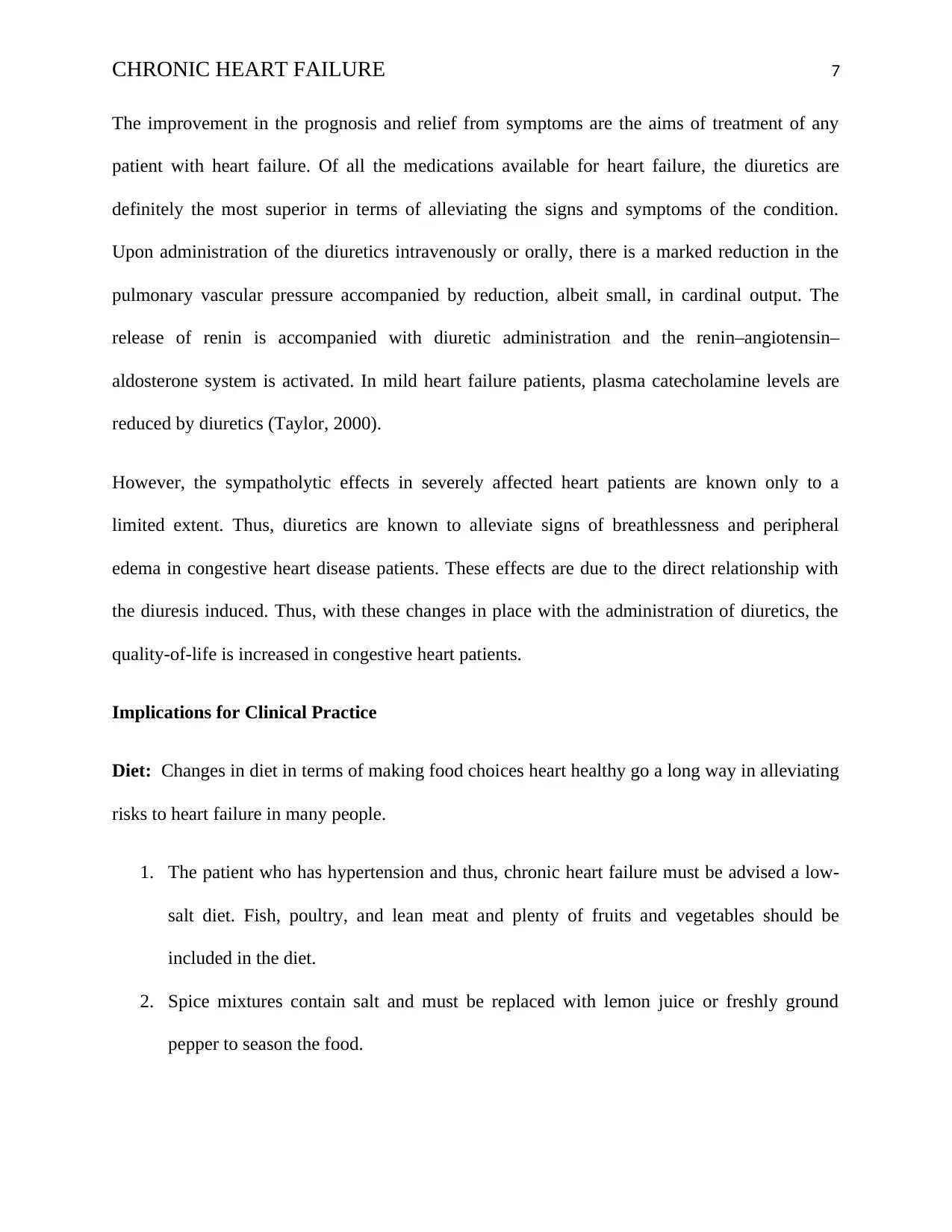
CHRONIC HEART FAILURE 7
The improvement in the prognosis and relief from symptoms are the aims of treatment of any
patient with heart failure. Of all the medications available for heart failure, the diuretics are
definitely the most superior in terms of alleviating the signs and symptoms of the condition.
Upon administration of the diuretics intravenously or orally, there is a marked reduction in the
pulmonary vascular pressure accompanied by reduction, albeit small, in cardinal output. The
release of renin is accompanied with diuretic administration and the renin–angiotensin–
aldosterone system is activated. In mild heart failure patients, plasma catecholamine levels are
reduced by diuretics (Taylor, 2000).
However, the sympatholytic effects in severely affected heart patients are known only to a
limited extent. Thus, diuretics are known to alleviate signs of breathlessness and peripheral
edema in congestive heart disease patients. These effects are due to the direct relationship with
the diuresis induced. Thus, with these changes in place with the administration of diuretics, the
quality-of-life is increased in congestive heart patients.
Implications for Clinical Practice
Diet: Changes in diet in terms of making food choices heart healthy go a long way in alleviating
risks to heart failure in many people.
1. The patient who has hypertension and thus, chronic heart failure must be advised a low-
salt diet. Fish, poultry, and lean meat and plenty of fruits and vegetables should be
included in the diet.
2. Spice mixtures contain salt and must be replaced with lemon juice or freshly ground
pepper to season the food.
The improvement in the prognosis and relief from symptoms are the aims of treatment of any
patient with heart failure. Of all the medications available for heart failure, the diuretics are
definitely the most superior in terms of alleviating the signs and symptoms of the condition.
Upon administration of the diuretics intravenously or orally, there is a marked reduction in the
pulmonary vascular pressure accompanied by reduction, albeit small, in cardinal output. The
release of renin is accompanied with diuretic administration and the renin–angiotensin–
aldosterone system is activated. In mild heart failure patients, plasma catecholamine levels are
reduced by diuretics (Taylor, 2000).
However, the sympatholytic effects in severely affected heart patients are known only to a
limited extent. Thus, diuretics are known to alleviate signs of breathlessness and peripheral
edema in congestive heart disease patients. These effects are due to the direct relationship with
the diuresis induced. Thus, with these changes in place with the administration of diuretics, the
quality-of-life is increased in congestive heart patients.
Implications for Clinical Practice
Diet: Changes in diet in terms of making food choices heart healthy go a long way in alleviating
risks to heart failure in many people.
1. The patient who has hypertension and thus, chronic heart failure must be advised a low-
salt diet. Fish, poultry, and lean meat and plenty of fruits and vegetables should be
included in the diet.
2. Spice mixtures contain salt and must be replaced with lemon juice or freshly ground
pepper to season the food.
Paraphrase This Document
Need a fresh take? Get an instant paraphrase of this document with our AI Paraphraser

CHRONIC HEART FAILURE 8
3. The food labels must be read by the patient when he/she is buying packaged food. If the
salt or sodium is above the allowed amount per day in the packaged food, then one must
refrain from purchasing it.
Exercise: Patients suffering from chronic heart failure need complementary strength training so
as increase their muscle strength and mass. Research has pointed out that dynamic resistance
exercises are well tolerated in CHF.
However, care should be taken that the exercising involves: 1) a small group of muscles, 2) work
phase are maintained for short periods, 3) repetition per se is small, and 4) the initial intensity of
contraction is low.
Diuretics: In patients with heart failure, the volume status must be evaluated and optimized as
part of the drug regimen. Diuretics therapy helps to remove the excess of extracellular fluids and
helps treat edema as a measure of volume management in patients with chronic heart failure
(Taylor, 2000)).
Thus, Charlie’s overweight problems are taken care of by exercise and diet, while his
breathlessness and edema are taken care of by diuretics.
In terms of implications of care plan, it can be said that it is essential for the medical
practitioners to focus on suitable therapeutic treatment so that health facets can be improved
accordingly. Moreover, emphasis should also be laid on giving medical treatment on frequent
basis. Proper dietary should be followed upon so that sedentary lifestyle can be avoided. This
might impact the health aspects of Charlie; hence recommended practices should be adhered
accordingly.
3. The food labels must be read by the patient when he/she is buying packaged food. If the
salt or sodium is above the allowed amount per day in the packaged food, then one must
refrain from purchasing it.
Exercise: Patients suffering from chronic heart failure need complementary strength training so
as increase their muscle strength and mass. Research has pointed out that dynamic resistance
exercises are well tolerated in CHF.
However, care should be taken that the exercising involves: 1) a small group of muscles, 2) work
phase are maintained for short periods, 3) repetition per se is small, and 4) the initial intensity of
contraction is low.
Diuretics: In patients with heart failure, the volume status must be evaluated and optimized as
part of the drug regimen. Diuretics therapy helps to remove the excess of extracellular fluids and
helps treat edema as a measure of volume management in patients with chronic heart failure
(Taylor, 2000)).
Thus, Charlie’s overweight problems are taken care of by exercise and diet, while his
breathlessness and edema are taken care of by diuretics.
In terms of implications of care plan, it can be said that it is essential for the medical
practitioners to focus on suitable therapeutic treatment so that health facets can be improved
accordingly. Moreover, emphasis should also be laid on giving medical treatment on frequent
basis. Proper dietary should be followed upon so that sedentary lifestyle can be avoided. This
might impact the health aspects of Charlie; hence recommended practices should be adhered
accordingly.
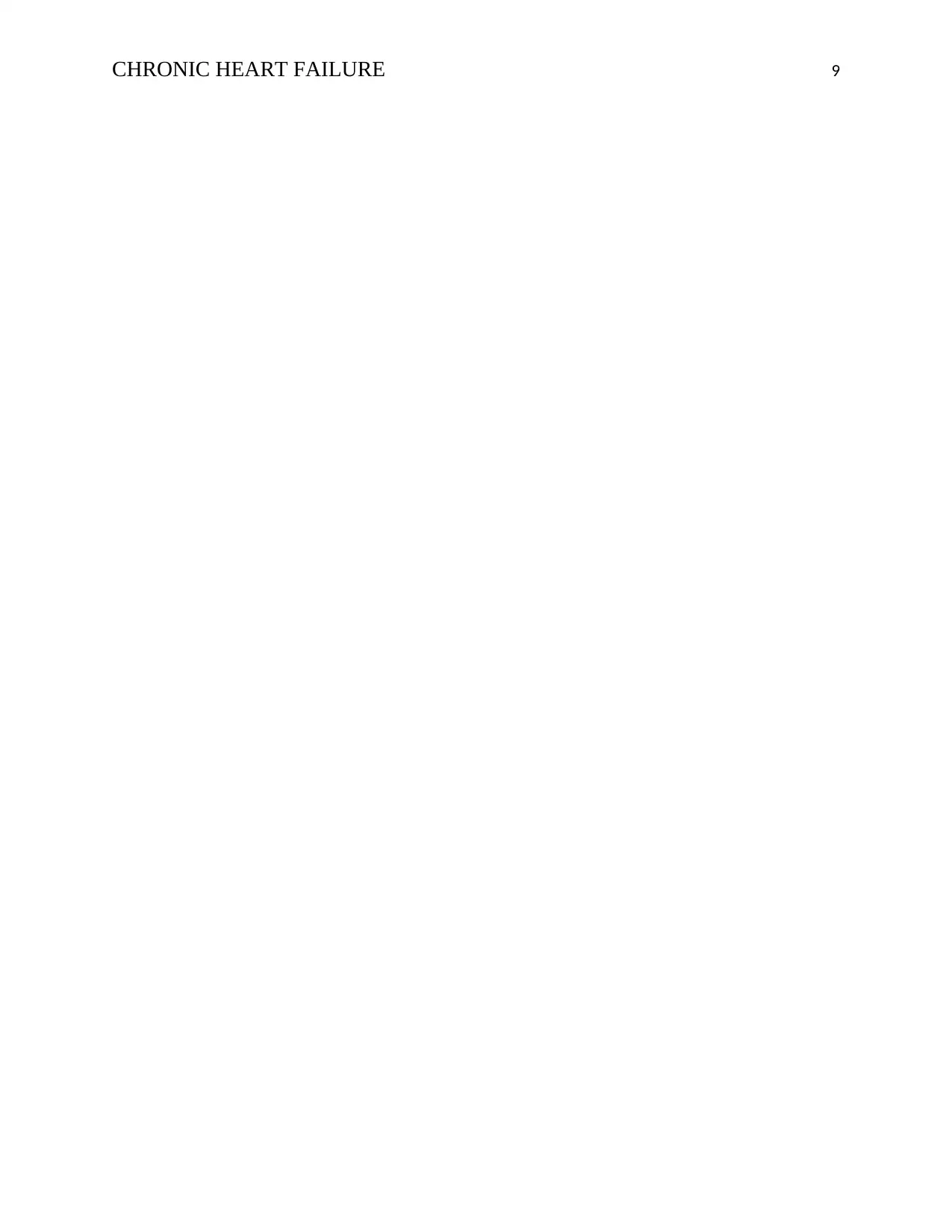
CHRONIC HEART FAILURE 9
⊘ This is a preview!⊘
Do you want full access?
Subscribe today to unlock all pages.

Trusted by 1+ million students worldwide
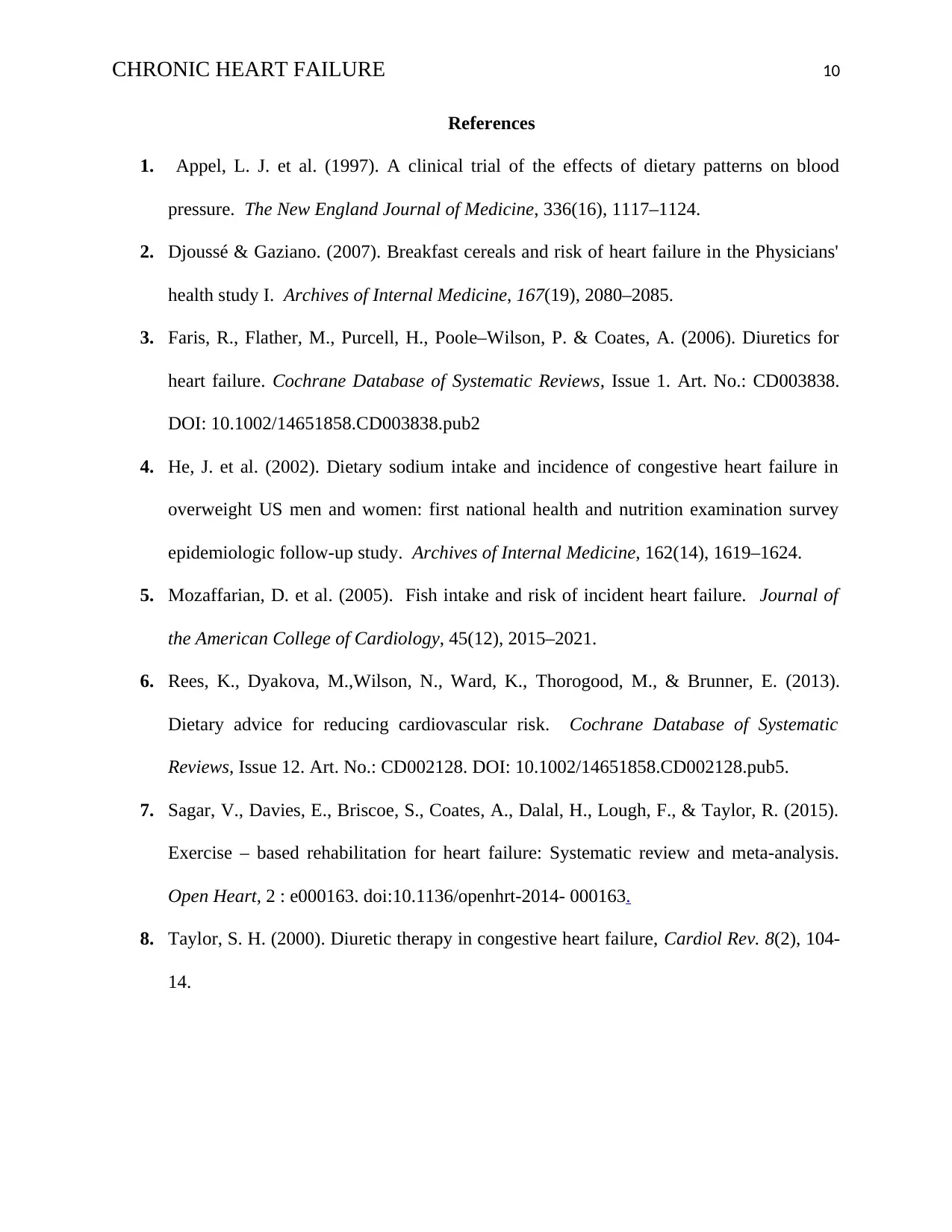
CHRONIC HEART FAILURE 10
References
1. Appel, L. J. et al. (1997). A clinical trial of the effects of dietary patterns on blood
pressure. The New England Journal of Medicine, 336(16), 1117–1124.
2. Djoussé & Gaziano. (2007). Breakfast cereals and risk of heart failure in the Physicians'
health study I. Archives of Internal Medicine, 167(19), 2080–2085.
3. Faris, R., Flather, M., Purcell, H., Poole–Wilson, P. & Coates, A. (2006). Diuretics for
heart failure. Cochrane Database of Systematic Reviews, Issue 1. Art. No.: CD003838.
DOI: 10.1002/14651858.CD003838.pub2
4. He, J. et al. (2002). Dietary sodium intake and incidence of congestive heart failure in
overweight US men and women: first national health and nutrition examination survey
epidemiologic follow-up study. Archives of Internal Medicine, 162(14), 1619–1624.
5. Mozaffarian, D. et al. (2005). Fish intake and risk of incident heart failure. Journal of
the American College of Cardiology, 45(12), 2015–2021.
6. Rees, K., Dyakova, M.,Wilson, N., Ward, K., Thorogood, M., & Brunner, E. (2013).
Dietary advice for reducing cardiovascular risk. Cochrane Database of Systematic
Reviews, Issue 12. Art. No.: CD002128. DOI: 10.1002/14651858.CD002128.pub5.
7. Sagar, V., Davies, E., Briscoe, S., Coates, A., Dalal, H., Lough, F., & Taylor, R. (2015).
Exercise – based rehabilitation for heart failure: Systematic review and meta-analysis.
Open Heart, 2 : e000163. doi:10.1136/openhrt-2014- 000163.
8. Taylor, S. H. (2000). Diuretic therapy in congestive heart failure, Cardiol Rev. 8(2), 104-
14.
References
1. Appel, L. J. et al. (1997). A clinical trial of the effects of dietary patterns on blood
pressure. The New England Journal of Medicine, 336(16), 1117–1124.
2. Djoussé & Gaziano. (2007). Breakfast cereals and risk of heart failure in the Physicians'
health study I. Archives of Internal Medicine, 167(19), 2080–2085.
3. Faris, R., Flather, M., Purcell, H., Poole–Wilson, P. & Coates, A. (2006). Diuretics for
heart failure. Cochrane Database of Systematic Reviews, Issue 1. Art. No.: CD003838.
DOI: 10.1002/14651858.CD003838.pub2
4. He, J. et al. (2002). Dietary sodium intake and incidence of congestive heart failure in
overweight US men and women: first national health and nutrition examination survey
epidemiologic follow-up study. Archives of Internal Medicine, 162(14), 1619–1624.
5. Mozaffarian, D. et al. (2005). Fish intake and risk of incident heart failure. Journal of
the American College of Cardiology, 45(12), 2015–2021.
6. Rees, K., Dyakova, M.,Wilson, N., Ward, K., Thorogood, M., & Brunner, E. (2013).
Dietary advice for reducing cardiovascular risk. Cochrane Database of Systematic
Reviews, Issue 12. Art. No.: CD002128. DOI: 10.1002/14651858.CD002128.pub5.
7. Sagar, V., Davies, E., Briscoe, S., Coates, A., Dalal, H., Lough, F., & Taylor, R. (2015).
Exercise – based rehabilitation for heart failure: Systematic review and meta-analysis.
Open Heart, 2 : e000163. doi:10.1136/openhrt-2014- 000163.
8. Taylor, S. H. (2000). Diuretic therapy in congestive heart failure, Cardiol Rev. 8(2), 104-
14.
1 out of 10
Related Documents
Your All-in-One AI-Powered Toolkit for Academic Success.
+13062052269
info@desklib.com
Available 24*7 on WhatsApp / Email
![[object Object]](/_next/static/media/star-bottom.7253800d.svg)
Unlock your academic potential
Copyright © 2020–2025 A2Z Services. All Rights Reserved. Developed and managed by ZUCOL.



